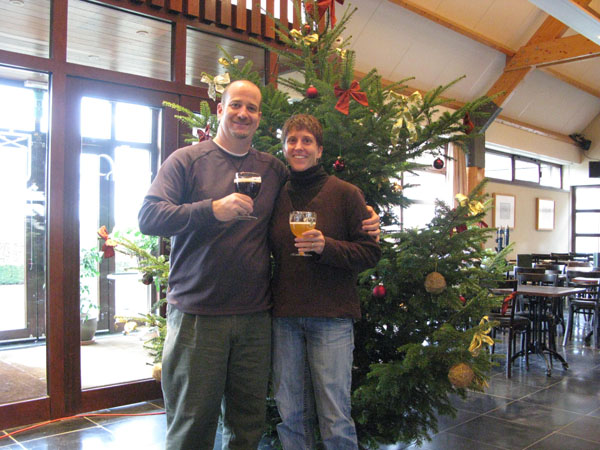 Yesterday was probably one of the biggest days in all our beer travels. Not only we were visiting the brewery with the most elusive beer in the world, Westvleteren, we were also visiting a nearby brewery that makes one of the most unique beers in the world, Rodenbach. In planning the trip, this was the day I was most excited about.
Yesterday was probably one of the biggest days in all our beer travels. Not only we were visiting the brewery with the most elusive beer in the world, Westvleteren, we were also visiting a nearby brewery that makes one of the most unique beers in the world, Rodenbach. In planning the trip, this was the day I was most excited about.
Unfortunately, health didn’t completely cooperate. The first few Flogging Molly days of the trip, we mingled with a bunch of people who had been sick over the previous weeks. I had been sniffly over the past few days, but yesterday was the first day I felt like crap. And it had nothing to do with all the beers I drank the previous night at ‘t Brugs Beertje.
After conveniently ignoring the wakeup alarm, we finally got on the road an hour late. Our first stop was the Sint Sixtus Abbey, home to the most sought after beer in the world, Westvleteren. It was a longer drive from Bruges than I imagined, with the last few kilometers down these one-lane country roads being the most frustrating. One the one hand, I felt like shit. But I also had the adrenaline pumping in anticipation of trying supposedly the world’s best beer.
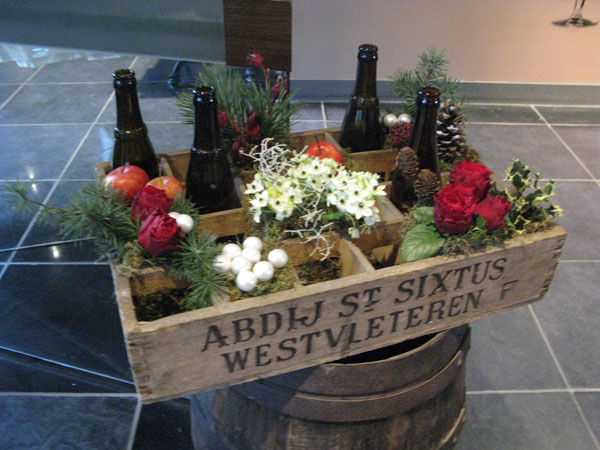 Finally we parked and I rushed up to their cafe/restaurant, In de Vrede, to make sure they were open. All good. We quickly found a table and instead of waiting for the waitress, I rushed over the counter to order two beers.
Finally we parked and I rushed up to their cafe/restaurant, In de Vrede, to make sure they were open. All good. We quickly found a table and instead of waiting for the waitress, I rushed over the counter to order two beers.
Before the beers arrived, we decided that we should buy beer to take home to California now. The beers they sell are very limited and can quickly run out. You can still stand in a long line to buy beer from the little window over at the Abbey, but now there is also a more civilized way to buy your beer. There is a little store in In de Vrede. I think the only advantage of buying across the street at the Abbey is that you get the cool wooden tray instead of a paper six-pack holder.
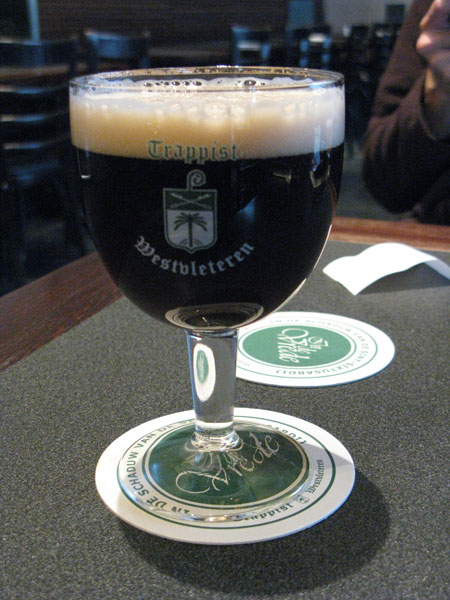 And being the Westvleteren rookie, I tried to buy 8 bottles of Blonde and 12 bottles of Westvleteren 8, the two beers available for purchase. I placed this request despite having read previously that a person can only buy a six-pack each. I blame the rookie maneuver on the mixture of sickness and adrenaline. In the end, I ended up with 6 bottles of Westvleteren 8. Returning to the table, I sent Merideth over to the little shop and she purchased her six bottles of Westvleteren 8.
And being the Westvleteren rookie, I tried to buy 8 bottles of Blonde and 12 bottles of Westvleteren 8, the two beers available for purchase. I placed this request despite having read previously that a person can only buy a six-pack each. I blame the rookie maneuver on the mixture of sickness and adrenaline. In the end, I ended up with 6 bottles of Westvleteren 8. Returning to the table, I sent Merideth over to the little shop and she purchased her six bottles of Westvleteren 8.
With all the beer purchasing settled, it was time to try the beer. We tried all three, Blonde, Westvleteren 8 and Westvleteren 12. I have to say that each are really, really, really good. Westvleteren 12 was still young; it could use years of mellowing. I could see myself sipping the Blonde or Westvleteren 8 all day long.
Are they the best in the world? I would say ‘Yes’ at the moment I tasted them, but that statement is probably tied into the whole journey to get to the point of me actually trying them. I had the same feeling the other day when I drank Orval at their Abbey. In the end, it is the experience that is at the heart of beer travel.
 Moving on, we visited the town of Poperinge, the center of hop production in Belgium. Unfortunately, the national hop museum was closed for the season, so we just walked around town for a bit and smiled at town’s numerous hop adornments. We did buy some hop-shaped chocolates. We also double-checked to see if the recommended beer bars were really closed on Wednesdays. They were.
Moving on, we visited the town of Poperinge, the center of hop production in Belgium. Unfortunately, the national hop museum was closed for the season, so we just walked around town for a bit and smiled at town’s numerous hop adornments. We did buy some hop-shaped chocolates. We also double-checked to see if the recommended beer bars were really closed on Wednesdays. They were.
We finished up our Poperinge with a sobering visit to the city hall. World War I raged in this area, the battlefields of Ypres(Ieper) are just a few kilometers down the road. The nearby countryside is dotted with Commonwealth war graves, the final resting place for soldiers from Canada, New Zealand, Ireland, Australia and the UK.
In the less enlightened times of the years 1914-18, shell shock victims were shot for being cowards. And in the courtyard of the Poperinge city hall, there is the memorial to British soldiers executed here for desertion. Not sure if the post is original but you can also visit the cells where they spent their final hours.
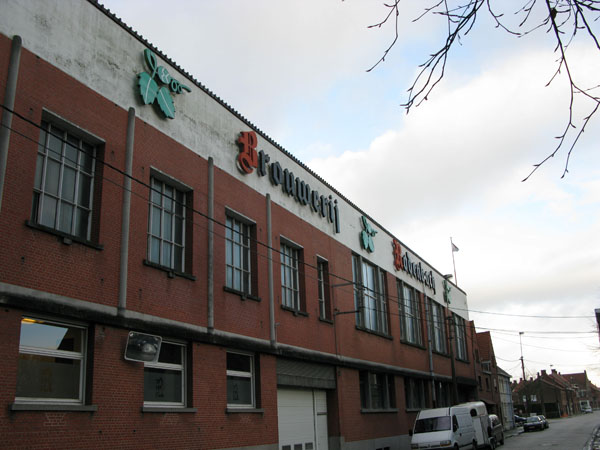 Then it was off to Roeselare and the Rodenbach brewery tour. I have been going through a serious ‘sour’ phase for the past year and Rodenbach’s Grand Cru is a chief reason for it. I was determined to visit Rodenbach while we here.
Then it was off to Roeselare and the Rodenbach brewery tour. I have been going through a serious ‘sour’ phase for the past year and Rodenbach’s Grand Cru is a chief reason for it. I was determined to visit Rodenbach while we here.
We are not normally into organized brewery tours, but that was the only way we could see the oak barrels, the secret behind the unique Rodenbach beer. I contacted the brewery several weeks ago and luckily there was a English language tour happening yesterday. Luckily, I say because English tours are rare at Rodenbach and we have done brewery tours in a language we can’t understand before and they are kind of boring.
 Our group primarily consisted of people from NATO. There were about 20 of them and the 2 of us. After watching a short video on the family history while sipping regular Rodenbach, we set off on the tour of the brewery. We were shown the brewhouse, from the outside, and the old malting facility from the time when Rodenbach did their own malting.
Our group primarily consisted of people from NATO. There were about 20 of them and the 2 of us. After watching a short video on the family history while sipping regular Rodenbach, we set off on the tour of the brewery. We were shown the brewhouse, from the outside, and the old malting facility from the time when Rodenbach did their own malting.
But the real star of the show are the oak barrels. There are 294 of these massive vessels some as much as 150 years old. Walking through room after room of the Grand Cru in the making, I only wished that I had one of the keys that worked the sampling spigot.
Rodenbach employs two coopers to keep them in working order and maintenance includes being ‘scraped’ every 12 years.
It is in these barrels that Grand Cru gets its magic. After two years of aging, the beer from different barrels is blended to create the final product.
We finished off our day by tasting Grand Cru. And what a day is was… visiting two gems of the brewing world… the rarest and maybe the most unique.
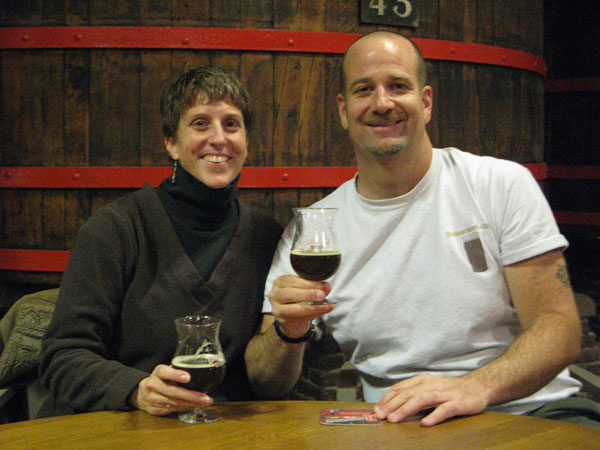

 We started the day off with a drive out to Chimay in Scourmont. There is a town nearby called Chimay, but that’s not where the abbey, brewery, or the official tavern (Auberge de Poteaupré) is.
We started the day off with a drive out to Chimay in Scourmont. There is a town nearby called Chimay, but that’s not where the abbey, brewery, or the official tavern (Auberge de Poteaupré) is. We then made a quick stop to the farm brewery of Dupont. We went to their official tavern across the street, which was a little awkward. Clearly we were from out of town. The local farmer guy didn’t speak English and we didn’t speak French. He got a kick out of us doing a tad bit of filming and I think he offered to film/take a picture of us. I somewhat mistook this and decided to get him in the video. In a rare moment of forwardness, I went up to him with my beer, said “cheers!” and toasted him. I’m not sure he knew what hit him. I haven’t seen the video, but Chris said that it is kind of out of place, so probably won’t make the final cut. I tried to give Farmer Henri his 15 minutes, but Chris is the editor. I’m just the on air talent.
We then made a quick stop to the farm brewery of Dupont. We went to their official tavern across the street, which was a little awkward. Clearly we were from out of town. The local farmer guy didn’t speak English and we didn’t speak French. He got a kick out of us doing a tad bit of filming and I think he offered to film/take a picture of us. I somewhat mistook this and decided to get him in the video. In a rare moment of forwardness, I went up to him with my beer, said “cheers!” and toasted him. I’m not sure he knew what hit him. I haven’t seen the video, but Chris said that it is kind of out of place, so probably won’t make the final cut. I tried to give Farmer Henri his 15 minutes, but Chris is the editor. I’m just the on air talent. Despite my limited French, I read on the menu that if you go there on your birthday, you get a free taster set. I pulled out my passport and “voila!”, I had a free taster set! I thought the server would act somewhat surprised and at least tell me “Happy Birthday”, but he didn’t. I was tickled, but admit that it was delivered somewhat unceremoniously.
Despite my limited French, I read on the menu that if you go there on your birthday, you get a free taster set. I pulled out my passport and “voila!”, I had a free taster set! I thought the server would act somewhat surprised and at least tell me “Happy Birthday”, but he didn’t. I was tickled, but admit that it was delivered somewhat unceremoniously. The beer list was overwhelming, but the owner Daisy was a fantastic help in recommending beers. Again, in a moment of forwardness not in my usual nature, I told her it was my birthday and asked if I could take a picture with her behind the bar. She agreed because it was my birthday. Another patron got into the act and we got a picture of both Chris and I with Daisy, as well. As we were leaving, she gave me a stuffed little brown bear. A beer lover’s birthday dream!
The beer list was overwhelming, but the owner Daisy was a fantastic help in recommending beers. Again, in a moment of forwardness not in my usual nature, I told her it was my birthday and asked if I could take a picture with her behind the bar. She agreed because it was my birthday. Another patron got into the act and we got a picture of both Chris and I with Daisy, as well. As we were leaving, she gave me a stuffed little brown bear. A beer lover’s birthday dream!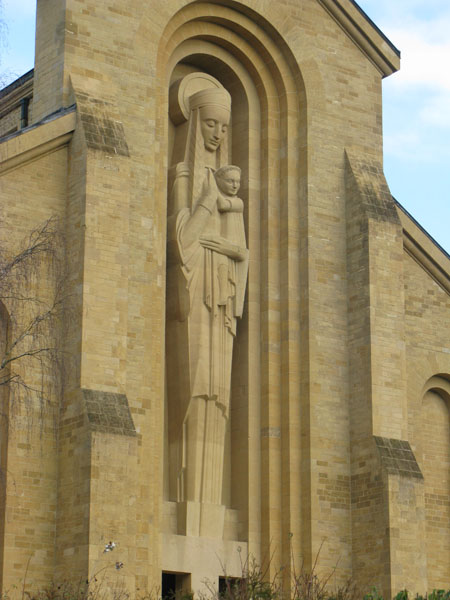 Our days have definitely slowed down, but have been very exciting! After filling up on a great breakfast at our hotel, we were ready to face our Sunday. The biggest goal for the day was to visit Orval, our third Trappist. Chris was a little unsure of the hours and wondered if they would even be open at all. So with some apprehension and crossed fingers we set off on the half hour drive. Lucky for us, the heavens were on our side. The official tavern next to the abbey was open, the abbey grounds were open to visitors, and to top it off, the sun was so bright it hurt my eyes. It was the first time we had seen the sun on the whole trip.
Our days have definitely slowed down, but have been very exciting! After filling up on a great breakfast at our hotel, we were ready to face our Sunday. The biggest goal for the day was to visit Orval, our third Trappist. Chris was a little unsure of the hours and wondered if they would even be open at all. So with some apprehension and crossed fingers we set off on the half hour drive. Lucky for us, the heavens were on our side. The official tavern next to the abbey was open, the abbey grounds were open to visitors, and to top it off, the sun was so bright it hurt my eyes. It was the first time we had seen the sun on the whole trip.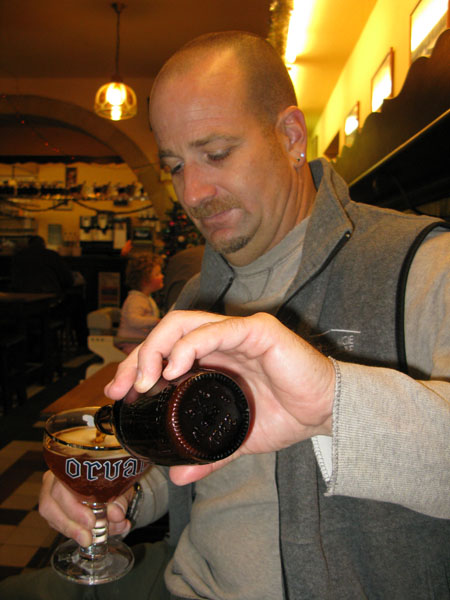 We were just relieved that the tavern, A l’Ange Gardien, was open. I suggested that we go in to have a beer before they had a chance to close. Sounds paranoid, I know, but it’s from past experience that I have such concerns. We started off with Petit Orval. A 3.2% diluted version of the regular Orval, Petit Orval is found only at the abbey and is created especially for the brothers. Using my usual descriptor, it was ‘good’. One could even say it was a true session beer from God.
We were just relieved that the tavern, A l’Ange Gardien, was open. I suggested that we go in to have a beer before they had a chance to close. Sounds paranoid, I know, but it’s from past experience that I have such concerns. We started off with Petit Orval. A 3.2% diluted version of the regular Orval, Petit Orval is found only at the abbey and is created especially for the brothers. Using my usual descriptor, it was ‘good’. One could even say it was a true session beer from God. We did get to see Mathilde’s Fountain, the water of which comes from the same source as that used in both the beer and cheese. The story goes that Mathilde, a member of royalty, was looking in the pond and her wedding ring fell into the water. She reportedly prayed at the abbey for its return. Within days, a fish appeared at the surface with her ring in its mouth. Hence, Orval’s logo of a fish with a ring in its mouth. In good royal fashion, she donated a lot of money to the abbey after that.
We did get to see Mathilde’s Fountain, the water of which comes from the same source as that used in both the beer and cheese. The story goes that Mathilde, a member of royalty, was looking in the pond and her wedding ring fell into the water. She reportedly prayed at the abbey for its return. Within days, a fish appeared at the surface with her ring in its mouth. Hence, Orval’s logo of a fish with a ring in its mouth. In good royal fashion, she donated a lot of money to the abbey after that. We drove further on to Le Pichet in the town of Hastiere. Mentioned in the Good Beer Guide to Belgium, its claim to fame is not only a fantastic beer list, but also that the meats are cooked on an open wood fire. They didn’t speak English and our French pronunciation leaves a lot to be desired, but we pointed and mangled the language. Then we watched our jambonneau and sauciss cook on the grill as we drank Achel and Rodenbach. We were kept further occupied by a scruffy Benji-type dog that begged at our table and nipped at the local children as they harassed him. From what we can gather, his name was “Puppy”.
We drove further on to Le Pichet in the town of Hastiere. Mentioned in the Good Beer Guide to Belgium, its claim to fame is not only a fantastic beer list, but also that the meats are cooked on an open wood fire. They didn’t speak English and our French pronunciation leaves a lot to be desired, but we pointed and mangled the language. Then we watched our jambonneau and sauciss cook on the grill as we drank Achel and Rodenbach. We were kept further occupied by a scruffy Benji-type dog that begged at our table and nipped at the local children as they harassed him. From what we can gather, his name was “Puppy”.
 Fantôme holds an important place in my beer education. It was their beer that started me appreciating Belgian beers. Fantôme was not my first Belgian, but before Fantôme, I didn’t really think twice about them. Post tasting Fantôme, I knew I needed to explore the uniqueness that is Belgian brewing.
Fantôme holds an important place in my beer education. It was their beer that started me appreciating Belgian beers. Fantôme was not my first Belgian, but before Fantôme, I didn’t really think twice about them. Post tasting Fantôme, I knew I needed to explore the uniqueness that is Belgian brewing. We drove on to the town of Rochefort and after a wrong turn and a bit of hunting and searching we found the abbey. Besides the wrong turn, it took some time as the abbey is not signposted until the you find the road it is on, plus we entered the side of town opposite of the abbey.
We drove on to the town of Rochefort and after a wrong turn and a bit of hunting and searching we found the abbey. Besides the wrong turn, it took some time as the abbey is not signposted until the you find the road it is on, plus we entered the side of town opposite of the abbey. We still needed to try the beer so we drove 2km up the road to the unofficial brewery tap, Le Relais St. Remy. As we walked up, there was, of course, that anxious moment as to whether they were open or not. Much to our glee, we noticed an older couple enjoying a meal, so all was good.
We still needed to try the beer so we drove 2km up the road to the unofficial brewery tap, Le Relais St. Remy. As we walked up, there was, of course, that anxious moment as to whether they were open or not. Much to our glee, we noticed an older couple enjoying a meal, so all was good. Then it was the 26km drive back to Fantôme, which was much shorter this time because we didn’t take the wrong turn. The brewery and adjoining tasting room is located on the main road that runs through the small town of Soy.
Then it was the 26km drive back to Fantôme, which was much shorter this time because we didn’t take the wrong turn. The brewery and adjoining tasting room is located on the main road that runs through the small town of Soy. Funky could also describe the beers. We tried the regular Fantôme, which can only be described as an apple bomb. This was the beer that first awoke me to the uniqueness of Belgians. They also had the Brune, which according to CAMRA’s Good Beer Guide to Belgium, is a rare occurrence. So, we savored the Brune, which had a strong raspberry flavor. There was a chocolate version, too, but not available for tasting, so Merideth bought a bottle of that to take with her.
Funky could also describe the beers. We tried the regular Fantôme, which can only be described as an apple bomb. This was the beer that first awoke me to the uniqueness of Belgians. They also had the Brune, which according to CAMRA’s Good Beer Guide to Belgium, is a rare occurrence. So, we savored the Brune, which had a strong raspberry flavor. There was a chocolate version, too, but not available for tasting, so Merideth bought a bottle of that to take with her. It was time to head further south almost to France to the town of Bouillion, our home for the night. But on the way we stopped at a war cemetery Merideth spotted. War cemeteries are our favorite historical places to visit in Europe mainly because they are the most poignant and thought provoking monuments in Europe.
It was time to head further south almost to France to the town of Bouillion, our home for the night. But on the way we stopped at a war cemetery Merideth spotted. War cemeteries are our favorite historical places to visit in Europe mainly because they are the most poignant and thought provoking monuments in Europe.
 Friday we were finally ready to get down to the real reason for our visit to Belgium. Flogging Molly was headed back to the States and Ute back to Germany. So after burning the candles at both ends on the first two days, we finally had time for some serious beer work.
Friday we were finally ready to get down to the real reason for our visit to Belgium. Flogging Molly was headed back to the States and Ute back to Germany. So after burning the candles at both ends on the first two days, we finally had time for some serious beer work. Haven been only around since 1999, the brewery and it’s adjoining tasting room/cafe has a quite a school cafeteria look and feel. You even pick up trays and go down a line of food to a cash register at the end. And being cold, rainy, early December, we were two of maybe ten people in this cavernous hall. And definitely the youngest.
Haven been only around since 1999, the brewery and it’s adjoining tasting room/cafe has a quite a school cafeteria look and feel. You even pick up trays and go down a line of food to a cash register at the end. And being cold, rainy, early December, we were two of maybe ten people in this cavernous hall. And definitely the youngest.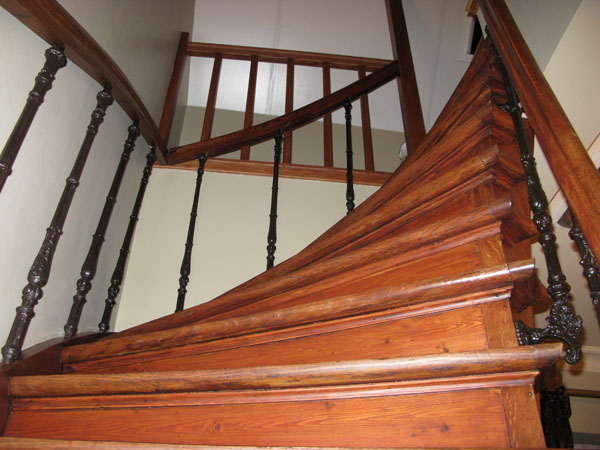 After two days of non-stop partying and the drive, we were pretty wiped out. Luckily, we were just staying a few kilometers down the road in Hamont. If you visit Achel and stay nearby, spend your night at Villa Christina in Hamont. The building is from the 1750s and has been transformed into a really nice Bed and Breakfast… probably the nicest we have ever stayed at. You do have to climb up an original set of steep stairs that I am sure would not pass any sort of safety inspection in this day and age.
After two days of non-stop partying and the drive, we were pretty wiped out. Luckily, we were just staying a few kilometers down the road in Hamont. If you visit Achel and stay nearby, spend your night at Villa Christina in Hamont. The building is from the 1750s and has been transformed into a really nice Bed and Breakfast… probably the nicest we have ever stayed at. You do have to climb up an original set of steep stairs that I am sure would not pass any sort of safety inspection in this day and age.